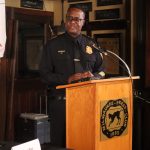2008
The Beat goes on
In a music career that has come full circle, Dave Wakeling has been on the right path from the very beginning. As a young man, he and his collaborators realized there was something magical in the “feet, hearts and mind” formula that came to define his group The English Beat. At the band’s apex they were surrounded by the royalty of the UK punk-era ska scene: The Selecter, Madness, The Specials and Elvis Costello. Originally dubbed The Beat, the band added the word “English” to their name stateside to avoid confusion with American power pop group the Paul Collins Beat. Signing to then-prestigious I.R.S. Records in 1981, Wakeling’s band found a measure of success in America with three solid albums and a string of wildly infectious dance floor-friendly singles. But before the roller-coaster ride really took off, Wakeling and his Birmingham buddies had already learned some valuable lessons. “We used to run parties with punk and ska DJs,” he said. “Each DJ alone would tire the dancers out, but the mix of punk and reggae equaled a full night of energy. What if you could get the both into the same songs? It was our punk-y reggae party. Boy George, members of UB40, the Au Pairs and Dexy’s Midnight Runners all came to the parties. Birmingham was going through one of its musical renaissances.” Falling under the spell of Led Zeppelin and Black Sabbath in their early 20s, Wakeling and Andy Cox (English Beat guitarist) both “were fierce music fans” and “very lucky in terms of time and geography.” Live shows were a priority, and Wakeling reels off a list of defining music moments that includes two Bob Marley concerts, seeing Van Morrison, the death of Tim Buckley and seeing the Buzzcocks. “The songs were catchy, two-and-a-half or three minutes long. [It was] the same for the Undertones and Wire, who used the hook and the art-form of the pop song.” The music made a lasting impression on them, but ultimately The Beat made their mark with their own hybrid of ska, punk, soul, reggae and Nigerian highlife. According to Wakeling, “After you’d been dancing awhile the lyrics hit even harder – it was like your mind was more open. We paired the beat with lyrics that were somewhat heavy. Life is ambiguous. It’s not all happy or sad.” In a lineup notable for both its racial integration and near mash-up style influences, the original six member band consisted of Dave Wakeling on vocals and guitar, Andy Cox on guitar, David Steele on bass, Everett Morton on drums, Ranking Roger on vocals and toasting and ska sax legend Papa Saxa. The Beat sound was born, but it needed to be heard. “Our bass player, said ‘One gig is worth a thousand rehearsals.’” Armed with a half dozen original tunes and a few covers, the band knocked out its first gig, opening for the Dum Dum Boys. It was shortly after the Three Mile Island nuclear accident and the band was […]
Feb 1st, 2008 by Blaine SchultzDrive-By Truckers
A departed band member can make the advent of a new album nerve-wracking rather than exciting for an ardent fan, but the absence of Jason Isbell, Drive-By Truckers’ singer of seven years, brings out a return to roots, as well as new directions. Brighter Than Creation’s Dark, the band’s eighth album, features contributions from band members who normally play the wallflower (bassist Shonna Tucker penned three shimmering beauties) paired with crunchier contributions from Patterson Hood, Mike Cooley and John Neff, with ‘icing on the cake’ keyboards by legendary Spooner Oldham. Southern rock had a glaring exterior when Lynyrd Skynyrd brought it to the mainstream, but today, one regularly hears the signature layered guitars, pedal steel, lazy drums and pretty keys channeling crusty stories of booze, drugs and hardships of alt-country on commercial radio. On Brighter Than Creation’s Dark, the Truckers juxtapose their personal brand of southern rock against established tradition. Their soft songs shine bright as the lights on a country wedding dance floor, while the gritty, raucous snarlers make the slow dancers shake their sleepy feet. Stories paste this album’s nineteen songs together. Cooley’s country-washed songs add humor with “Lisa’s Birthday” and “Bob,” the tale of a man whose mom is the only one “she lets call him Robert” and who “has always had more dogs than he ever had friends.” Hood pens staunch southern rock with such vigor and drama it draws goose bumps. “The Man I Shot” is chilling, a strong contrast to Tucker’s gentle writing and Cooley’s ‘aw, shucks’ style. Hood’s slower ballads veer into Eagles territory at times, which can either please – in the case of the amazing “Daddy Needs a Drink,” made stellar by heart-wrenching pedal steel – or annoy, as on “The Home Front,” which is lite rock at best. Brighter Than Creation’s Dark is an album to be traveled through, soaking in all the odd twists and turns, corners and dips. There are some bumpy spots, but the unexpected beauty will sink the listener like a stone, and the buoyant humor will lift the mood and ease the listener into reality, as the best stories often do.
Feb 1st, 2008 by Erin WolfYou don’t get a medal for showing up
At VITAL, our new year begins in February. I’d like to thank everyone once again for their support. It used to be a thrill just to write the rent check that proved we weren’t just a home office vanity project; as we’ve matured, though, my view of this whole endeavor has evolved. I have a thousand examples, but it all comes down to one idea, perfectly put by Thomas Jefferson: “I’m a great believer in luck, and I find the harder I work the more I have of it.” I now understand that our willingness to work our asses off is ultimately the reason we’re still here, far more than any visionary thinking or single lucky break. I was born in the ‘60s and influenced by both my grandparents’ work ethic and my father’s disdain for it (to be fair, he got over it later in life). Some of my peers joined Generation X. The rest of us went to work. Mine is the generation that brought about both the ubiquity of cocaine-derived drugs and many of the amazing technological advances that shape our world. The two extremes are actually closely related, both born of an inherent relentlessness, a desire to always move at the greatest possible speed, freed from barriers – of fatigue, social awkwardness, geography, even time itself. I’m not saying this is an entirely wonderful way to look at life; the socio-cultural fallout may not be fully measured in my lifetime. Even so, the ‘80s and ‘90s were a gas, a wild ride followed by a hard crash when the middle class economy slowed way down in the first years of the 21st century. But even before that I think there was collective pause, fueled in part by the regret of our parents, now missing the grandkids a thousand miles away, who saw what had become of their latchkey, Kraft dinner-consuming, Alex P. Keaton-channeling offspring. We had it all, but we traded too much to get it. The solution was clear: the next generation would be cared for with a vengeance. Sometime in the late 20th century, the desire to give one’s children “more” took on a new meaning: with the highest percentage of “affluent” Americans in our history, the trappings of attainment took on a nurturing mantle. It was the dawn of the age of the Soccer Mom, the bicycle helmet and the mentality that reasoning was a viable parenting philosophy. I admit it; I was initially swept into the new world order. My kid had a sticker chart that he filled up by performing such amazing feats as picking up his clothes and saying thank you. He actually earned toys for meeting the minimum expectations of socialization! But eventually, I saw what I, his teachers, his soccer coach and the rest of his network of support had wrought: a kid who expected to be rewarded for taking out the garbage. He’s a good boy: naturally nice, smart and funny. On the surface, he looks like […]
Feb 1st, 2008 by Jon Anne WillowCollections of Colonies of Bees
By Charlie Hosale The central aspect of Milwaukee natives Chris Rosenau and Jon Mueller’s musical projects has always been accessible experimentation. Collections of Colonies of Bees, thanks to an evolving and expanding lineup of musicians, have had a number of dynamically different sounds over the years. This new release finds the band on a new label with a filled-out lineup consisting of Jim Schoenecker, Daniel Spack, and Thomas Wincek. From the record’s first note, the change in the Bees’ sound and approach is palpable. Customer, released in 2004, found the group experimenting with free forms and electronics, with a focus on floating melody. Those influences are still present on Birds, but the band has shifted to a much more structured process. Instead of trying to see how far music can go, like the unconventional structure and melodic re-imaginings of Customer, they attempt to break music down to its simplest emotional form. Birds shifts to pulsing rhythms and delicately structured melodic layering to create a musical catharsis—something that, before Birds, the Bees hadn’t really done. Birds is an entirely different record for the Bees, but it still sounds like everything their listeners have come to love about them. Their songs have always sounded like instances of beauty, like a friend smiling or a tear dropping, and on Birds those pictures are still there; it just sounds like now the Bees are ready to take on the whole story, instead of only living in the moment.
Feb 1st, 2008 by Vital ArchivesBob Mould
Singer/songwriter/punk icon/former pro-wrestling scripter Bob Mould has (obviously) worn many hats during his career. With his latest solo offering, District Line, the ex-Hüsker Dü and Sugar guitarist continues hisbalancing act between modern rock balladeer and DIY wunderkind. Mould plays every instrument on District Line besides the cello, provided by Amy Domingues, and the signature drumming of Fugazi’s Brendan Canty. Canty’s distinctive dub-enhanced syncopation shines on the leadoff track “Stupid Now;” for most of the album, though, he’s content to simply lay a solid back beat. His playing echoes Mould’s songwriting; flashes of the work that made them both legends occasionally shine through what is essentially an album of sometimes competent, often excellent, generally straightforward alternative rock. Mould’s solo work is intensely personal and relationship-based. “Again and Again” recalls his 90’s alterna-pop incarnation, Sugar, with symphonic guitar driving a melancholy suicide note of dysfunctional love – “I took the bullets from the carport/tossed them in my backpack…I left the title to the house inside the piano bench/And my lawyer’s got the will.” This track, and the up-tempo (and equally Sugary) “Very Temporary,” shows the material at its strongest and catchiest. A strange fascination with vocoder (which, let’s face it, Cher ruined for everyone) threatens to undermine “Very Temporary” and otherwise fascinating tracks like the alterna-rock/disco mash-up “Shelter Me.” It’s frankly distracting to hear the voice behind incendiary punk classics like “Something I Learned Today” dabbling in NYC Eighth Avenue club music. Still, Mould’s determination to straddle the line between alternative and dance pays off more often than it stumbles on District Line. Now if only Bob would find the time to start scripting wrestling matches again. Lord knows the WWE could use him right now.
Feb 1st, 2008 by DJ HostettlerCheckers or Chess?
Maybe no one will win this election By Donald Kaul American elections are nothing if not amusing; solemn rituals laced with equal measures of irony and hypocrisy, with a touch of absurdity thrown in for taste. The victory speeches alone are worth the price of admission. Take for example the statement of Mitt Romney after he’d been declared winner of the Michigan caucuses: “Tonight is a victory of optimism over Washington-style pessimism,” he said. Implicit in that statement is the belief, widely held, unfortunately, that optimism is a good thing in and of itself, and that to be pessimistic is somehow un-American. Balderdash. Hogwash. Fiddle-faddle. There, having exhausted my supply of 19th Century rebukes, let me tell you why the idea is dangerous nonsense. A little optimism is fine, necessary, even. It helps one get up in the morning and face the day. When it reaches the point of self-delusion, however, it masks the real problems one faces and makes a solution impossible. Romney’s victory took place at the precise moment that the national economy seems poised to plunge into a full-blown recession and in a state that has been living that recession for the better part of a decade. Michigan’s unemployment rate, at about 8 percent, is the highest in the country; its chief economic engine, the auto industry, is reeling from foreign competition and shows little sign of recovering any time soon. Plants, one after another, keep closing. It doesn’t need optimism; it needs rescue. Romney says he can bring Michigan’s lost jobs home. By cutting taxes, of course. That’s the Republican answer to Hadacol. It cures all ills. Let me say this about that: Cutting taxes does not necessarily create jobs. Rich people and corporations do not invest in plants and equipment simply because they have the money to do so. There has to be some expectation of profit. And if there’s nobody out there with money to buy anything, that expectation does not exist. I will never know how Democrats keep losing elections to Republicans. The GOP has controlled Congress for most of the past dozen years and the presidency for the past seven. Having inherited a budget surplus, a boisterous economy and a healthy dollar, they’ve managed to squander those advantages and run the economy into a ditch. And now we’re seriously considering keeping a Republican in the White House? That’s like hiring Michael Vick as your dog walker. On second thought, I think I know how Democrats keep losing elections. Their ability to snatch defeat from the jaws of victory is all but supernatural. Take, for example, the decision of the national party to ignore the Michigan caucuses. Michigan, seeking to achieve some relevance in the presidential selection process, had moved its caucuses up right behind Iowa and New Hampshire. This so offended the leaders of the Democratic party that they punished the state by stripping it of its delegates at the national convention. The major presidential candidates went along with the gag (most […]
Feb 1st, 2008 by Vital ArchivesFurther Considerations
In part one of my look at the Inova/Kenilworth exhibition (now – March 14), I signed off with a few questions for the exhibit’s curator, Nicholas Frank. Because there has been controversy about the balance of men vs. women receiving Mary L. Nohl Fellowships, and because the current Inova/Kenilworth event features four women and one man, I thought this might be his way of smoothing things out. Here’s his reply: My programming isn’t a direct response to the Nohl Fellowship situation, because the problem is not with the Nohl program; it exists in the art world at large. I don’t think it’s difficult to program excellent exhibitions that reflect the actual gender balance among practicing artists. He continued his comments with some thoughts on shaping shows: I curate to reflect what artists are doing. The shows need to be relevant to the general art-going public, and also to the university audience, because we want Inova to be a curricular resource within the Peck School of the Arts. The drawing show illustrates the rise of drawing and narrative strategies among contemporary artists, and is useful for visual art faculty and students in that it expands notions of what drawing is and can be. There are sculptural, photographic and conceptual elements at play in this show, too. In an earlier conversation, Frank told me he considered 10 artists; he may possibly include the five who didn’t make the cut in a future show. I assume that they were all good choices, simply because Frank has a great eye for what works and what doesn’t. Curators must deal with all kinds of problems: availability of work, space and scheduling, which may conflict with artists’ other jobs. It’s a lot to consider, and Inova/Kenilworth is only one venue under the Peck banner; Frank also curates Inova/Arts Center and Inova/Zelazo (Mary L. Nohl Galleries). To give you an idea of how interwoven it all is, on February 6, Claire Pentecost, who is participating in the current Kenilworth show, will consider the “great tradition of drawing and its current place as a mediator between self and the social” at the Arts Center lecture hall. As Frank noted in his statement, the show includes “sculptural, photographic, and conceptual elements.” As a unit, the entire exhibit is provocative, but not over-the-top, and from my standpoint the drawing theme holds true while conveying social anxieties. This is no easy trick, for how does a fine artist use words like “flatulence” and “poop” (and other arguably vulgar words) in a way that makes you want to keep reading? Deb Sokolow does it via story-telling. Her choice is freedom of expression; she almost dares you to hang in there, to see if the text and images (attached to several walls with push pins and tape) will lead you to a satisfactory end. But don’t expect her tale to necessarily end well. Unless you are a true fan of the wild, it takes time to explore her work (she’s a fan of […]
Jan 28th, 2008 by Stella CretekDrawing Conclusions
Deb Sokolow: The Trouble with People You Don’t Know The Flight of Fake Tears: Large-Scale Narrative Drawing: Dominic McGill, Robyn O’Neil, Claire Pentecost, Amy Ruffo Peck School Of The Arts Institute of Visual Arts Inova/Kenilworth 2155 N. Prospect Ave. The Institute of Visual Arts in the splendid Inova/Kenilworth building welcomes their spring season with politics, pop culture and drawings (and photographs of drawings, plus a funky tent) of anxieties – to my mind, quite appropriate in a year already laden with political back-stabbing, crashing global markets and the continuing war. I left my condo on Prospect (I can see the Kenilworth from my north windows) armed with reams of print-outs detailing the heavy credentials of the participants. Curator Nicholas Frank is reason enough to pay attention to this show, though I figured if boredom set in I could duck into Urban Outfitters next door and peruse crazy in-your-face retail items. Reviewing group exhibitions often (unless the work is wretched) demands several visits and careful consideration. James Auer, the late Milwaukee Journal Sentinel art critic, solved this problem by listing some of the artists in group shows he reviewed as “others,” thus eliminating names and lengthy text with a stroke of his powerful pen. Any artist who’s ever been identified as an “other” knows that it stings like a bee. The Inova/Kenilworth event is divided into The Trouble with People You Don’t Know – works by Chicago-based artist Deb Sokolow – and The Flight of Fake Tears, which includes the talents of Dominic McGill, Robyn O’Neil, Claire Pentecost and Amy Ruffo. Ms. Sokolow will launch the Department of Visual Arts’ guest lecture series (“Artists Now!”) on January 30 at 7pm. This is the first of a three-part series to explore more fully the works of each artist. Curator Frank was on site when I visited (two days prior to the opening), and Bruce Knackert, Director of Galleries, was busy hammering and helping the artists with the installation process. At one point, Frank dashed out for latte and healthy stuff from Beans & Barley for artist Deb Sokolow, who had forgotten to eat! Dominic McGill’s canvas tent waited to be unpacked from its small cardboard box, while Claire Pentecost waited for some framed pieces to arrive. Propped on the north wall in a space Frank describes as a “cathedral space,” Robyn O’Neil’s graphite drawing had been freed from bubble wrap, but not yet installed. Amy Ruffo was due in at any moment, likely en route from Sheboygan where she is the special projects coordinator at the John Michael Kohler Arts Center. Sokolow spent much of her time down on her knees, cutting and preparing her narrative drawing, which snakes around a generous space and invites the viewer to keep going, reading and thinking and making choices. She’s a storyteller for sure. “I re-read lots of Nancy Drew books to prepare for this,” she remarked, adding that she’s in her studio so much that she doesn’t get much time to read things not […]
Jan 25th, 2008 by Stella CretekArabesque Music Ensemble
By Blaine Schultz Umm Kulthum was a very popular Arabic vocalis; in her beautiful and powerful voice, she performed songs composed for her by a trio of talented men. Zakariyya Ahmad, Muhammad al-Qasabji and Riyad al-Sunbati are known as the Three Musketeers. This album is made up of tunes written in the 1930s and 1940s – some of which were originally recorded for movies. This is not a reissue, but a contemporary project of the Chicago-based Arabesque Music Ensemble. It is a tribute to the composers. For these recordings, the ensemble worked with 75-year-old vocalist Youssef Kassab, who transcribed the original recordings. While most of the group members are in their 20s and 30s (and have recorded with Shakira and Beyonce), they sought to recreate the vibe of the original era. The Three Musketeers were traditionalists for the most part, but added touches of Western influene – hence the appearance of cello alongside ‘ud and qanun. Liner note translation of the lyrics speak of sacred and secular devotion and patriotism – love in its many forms. What stands out is the care the musicians took with this music. Lilting melodies glide and rage with ease. The Arabesque Music Ensemble performs February 5 at the DeKoven Center in Racine.
Jan 25th, 2008 by Vital ArchivesTrue West
Sam Shepard’s True West is a cleverly dark comedy that would be all too easy to overdo in all the wrong places. A less than shrewd production could miss the finesse of the original script, but the Spiral Theatre, in a tiny space on National Avenue, brings the right immediacy and intimacy to capture Shepard’s somewhat sinister humor with strikingly vivid form. In a testament to its growing prominence in local theatre, Spiral Theatre nearly sold out its 30+ capacity studio theatre on one of the coldest nights of the year. Spiral’s show is impressive, and while not all of the finer points of Shepard’s script are perfectly intact, the company manages to deliver an exceedingly enjoyable trip to the theatre. Len Macki stars as Austin, a struggling screenwriter who is looking after his mother’s place while she is away in Alaska. He’s managed to secure a meeting at her place with an important Hollywood producer (Josh Wetzel) to pitch an idea for a love story. The only problem: his brash older brother (Terry Gavin) is staying with him and threatens to blow Austin’s one chance at getting the producer’s green light. Things begin to unravel when Austin’s brother convinces the producer that it would be a good idea for Austin to write a Western instead. (Okay: Shepard’s plot is a lot better than it sounds in a few sentences. And if it’s not staged correctly, it’s every bit as cheesy as it sounds.) Len Macki, comfortably at the center of the production, holds much of the production together. (He’s not prominent locally, but he’s been active elsewhere, most notably Madison.) He dynamically renders Austin’s emotional development over the course of the play, moving from one intricately realized moment to the next. When Austin loses composure and takes to drinking, his emotional collapse is palpable. When he’s clearly dropping pieces of toast into toasters that aren’t plugged in, it makes sense even, though the illusion isn’t complete. Everything that happens around Austin makes sense, even when the production doesn’t make anything clear, and for that, Macki is truly remarkable. Gavin and Wetzel competently hold up their ends of the play. Gavin plays the seedy older brother with a subtle hint of a greater depth. Wetzel plays a Hollywood producer with a nice-guy charisma you wouldn’t expect from a man in his position. This contrast makes for an interesting performance; Wetzel seems almost guileless in a job one would expect to be played like a politician. Rounding out the cast is Sandra Stark in the role of the mother – again (during the holidays she appeared in Boulevard Theatre‘s production of Indian Blood). Seeing Stark play mother twice in three months would be strange if she weren’t so good at it. She speaks the lines. She doesn’t really need to do much more than that. She’s a natural for this kind of role, and here she’s a clever bookend to the production. Spiral Theatre’s production of True West runs through February […]
Jan 24th, 2008 by Russ BickerstaffRomancing the seed?
Seed Cycles: Works by Sally Kuzma Villa Terrace Decorative Arts Museum 2220 N. Terrace Avenue January 23 – April 6, 2008 Artist’s Talk: Sunday, February 24, 2 p.m. One would guess that the majority of visitors to the Royal Botanic Gardens, in Kew (near London), likely have little scientific interest in The Millennium Seed Bank Project (MSBP), entrenched on 300 acres. The venerable Botanic Gardens are no doubt gardens of earthly delights, but the Seed Bank Project is decidedly unromantic, in that its vision is to conserve seeds from the world’s wild plant species by the end of the decade. So far they’ve banked 10% of the rarest, “most threatened and most useful species known to man.” They are also scanning their massive herb collection with something called the HerbCat. Nearer to home, at the Villa Terrace Decorative Arts Museum, an elaborate Italianate showplace on a high bluff overlooking Lake Michigan, Milwaukee-based artist Sally Kuzma exhibits Seed Cycles, January 23-April 6. Her work is rooted in direct experiences with the natural world, specifically in the five years she spent in Iowa before moving to Milwaukee. The ongoing series (images of plant specimens scanned onto her computer and variously altered) is said to explore “the relationships people have with the natural world.” A preview is available at the artist’s website. As I write, I can’t help but thinking of photographer Tom Bamberger’s magnificent works which opened the gallery in the Inova/Kenilworth building, most particularly “Spring Corn,” a bleached-out, drained-of-emotion digitally altered photograph. As a former Iowan, I initially ogled the work through nostalgic eyes, even though the stark image was taken near Mequon. Coldly elegant and impersonal, the result was uncontrived, and it’s my guess that it took some doing to make it so. Frankly, I often need to remind myself that “nature is uncaring.” Of course Homo sapiens has forever altered the natural world, and artists of that species also alter it to fit their personal needs (and the demands of curators and text-panel writers), but beyond that, I think the “relationship” slant is a big ball of nothing. When I visit the Milwaukee Art Museum and stand before a painting by the 19th-century American landscape painter Thomas Moran (who is also represented in the collection of the Charles Allis Museum, a partner of Villa Terrace), I know I’m in a romantic space with romantic paintings, but what do they really reveal about the relationship between people and the natural world? To drive the point home, go online and take a look at New Orleans After The Flood, a series of photographs by Robert Polidori, stunning images about the Big Easy right after Katrina. Does nature give a hoot about “relationships?” I don’t think so. Kuzma somewhat clarified the relationship boondoggle in an email: “I don’t know if I’d claim to investigate the relationship people have with the natural world. The scanner and the computer are just a way to get a closer look at them. Like a scientist, I’m […]
Jan 23rd, 2008 by Stella CretekSay Goodnight, Gracie
At the end of the night, amidst echoes of laughter, it is difficult to leave the Boulevard Ensemble Studio Theatre’s Milwaukee premiere of Say Goodnight, Gracie. Yet there is plenty to consider afterwards in this 1978 script by Ralph Pape, whom in 2007 the Dramatist’s Guild of America selected as one of the country’s top 50 playwrights to watch. Five new and emerging actors carry this 90-minute, no-intermission evening, which conveys the Boulevard’s mission: to help young talent perfect their professional craft. Under the direction of Jon Beideschies, they create an exuberant energy and chemistry on the stage that brings both laughter and pathos to the production. The action revolves around two “almost 30-somethings” on the evening of their high school reunion. Jerry (Keith Tamsett) returns from another audition, told that “he will never, never, never play Hamlet on any stage.” Steve (Tom Dillon), an unpublished writer, lingers in Jerry’s tiny apartment, fantasizing that he has finally written a sitcom script that will finally make both of them famous. Add Jerry’s girlfriend Ginny (Rachael Lau), a somewhat successful singer, Bobby (Jason Will) and his sexually liberated girlfriend Catherine (Ericka Wade) to this pre-party exchange and the night blows away in a puff of marijuana smoke as everyone reminisces on the “high.” The group shares their surprising hopes, dreams and expectations as they discuss growing up during television’s “Golden Age” with Milton Berle and Groucho Marx. Tom Dillon’s Steve adeptly crafts his character with comic delight, while the women give capable performances. Tamsett leaves us wanting for more depth with his distressed Jerry, but it is Jason Will as Bobby who really brings the smoke; his lines are some of the most poignant, and they soften the laughter. “Everything cycles,” he says. “Like the three cycles on a washing machine … birth, life, and death … Everything comes around again so it doesn’t matter. Fifties, sixties, or seventies – it’s all the same.” As this disenchanted quintet discusses the Rolling Stone’s Mic Jagger – already an “old fart” in ’78 – and asks questions about going nowhere, the joy of being alive and the fear of the unknown, the play echoes with relevance more than a pure comedy could. Their realization that television and movies preserve the past, and that time passes quickly while the world changes, creates the wonder that perhaps tears are more appropriate than smiles when the lights go out at the end of Say Goodnight, Gracie. Tickets should sell out quickly at the Boulevard Theatre during this enjoyable production’s run before the last performance on February 3. VS
Jan 22nd, 2008 by Peggy Sue Dunigan



















